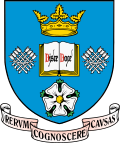Douglas Northcott
Douglas Geoffrey Northcott | |
|---|---|
| Born | Douglas Geoffrey Robertson 31 December 1916 Kensington, London, England |
| Died | 8 April 2005 (aged 88) Sheffield, Yorkshire, England |
| Alma mater | University of Cambridge |
| Known for | Ideal theory |
| Spouse |
Rose Hilda Austin
(m. 1949; died 1992) |
| Scientific career | |
| Institutions | |
| Thesis | Tauberian theorems for functions taking values in Banach spaces (1949) |
| Doctoral advisor | Frank Smithies |
Douglas Geoffrey Northcott, FRS (31 December 1916 – 8 April 2005)[1][2] was a British mathematician who worked on ideal theory.
Early life and career[edit]
Northcott was born Douglas Geoffrey Robertson in Kensington on 31 December 1916 to Clara Freda (née Behl) (1894–1958) and her first husband Geoffrey Douglas Spence Robertson (1894–1978). His mother remarried in 1919 to Arthur Hugh Kynaston Northcott (1887–1952). In 1935, he legally adopted his step-father's surname.[1]
He was educated in London, then at Christ's Hospital and St John's College, Cambridge, where he started research under the supervision of G.H. Hardy.
His work was interrupted by active service during World War II. Captured at Singapore, he survived his time as a prisoner of war in Japan, and returned to Cambridge at the end of the war.
Back at Cambridge, he published his dissertation "Abstract Tauberian theorems with applications to power series and Hilbert series ".[3][4] He then turned to algebra under the influence of Emil Artin, whom he had met while visiting Princeton University. He became a Research Fellow of St John's College in 1948.
In 1949, he proved[5] an important result in the theory of heights, namely that there are only finitely many algebraic numbers of bounded degree and bounded height. In analogy to this result, a set of algebraic numbers is said to satisfy the Northcott property if there are only finitely many elements of bounded height. [6][7]
In 1952, he moved to the Town Trust Chair of Pure Mathematics at Sheffield University. He remained at Sheffield until his retirement in 1982, also serving as Head of Department and Dean of Pure Science.
In 1954, Douglas Northcott and David Rees introduced in a joint paper[8] the Northcott-Rees theory of reductions and integral closures, which has subsequently been influential in commutative algebra.[9]
Awards[edit]
Northcott was awarded the London Mathematical Society Junior Berwick Prize in 1953 and served as LMS Vice-President during 1968-69. He was elected Fellow of the Royal Society in 1961.
Family life[edit]
In 1949, at Cambridge, Northcott married Rose Hilda Austin (1917-1992), with two daughters, Anne Patricia (born 1950) and Pamela Rose (1952-1992).
Publications[edit]
- Northcott, D. G. Multilinear algebra. Cambridge University Press, Cambridge, 1984. ISBN 0-521-26269-0
- Northcott, D. G. A first course of homological algebra. Reprint of 1973 edition. Cambridge University Press, Cambridge-New York, 1980. ISBN 0-521-29976-4
- Northcott, D. G. Affine sets and affine groups. London Mathematical Society Lecture Note Series, 39. Cambridge University Press, Cambridge-New York, 1980. ISBN 0-521-22909-X
- Northcott, D. G. Finite free resolutions. Cambridge Tracts in Mathematics, No. 71. Cambridge University Press, Cambridge-New York-Melbourne, 1976.
- Northcott, D. G. Lessons on rings, modules and multiplicities. Cambridge University Press, London 1968
- Northcott, D. G. An introduction to homological algebra. Cambridge University Press, New York 1960
- Northcott, D. G. Ideal theory. Cambridge Tracts in Mathematics and Mathematical Physics, No. 42. Cambridge, at the University Press, 1953.
References[edit]
- ^ Jump up to: a b Rees, D.; Sharp, R. Y. (2007). "Douglas Geoffrey Northcott. 31 December 1916 -- 8 April 2005: Elected FRS 1961". Biographical Memoirs of Fellows of the Royal Society. 53: 247. doi:10.1098/rsbm.2007.0010.
- ^ "Douglas Northcott at the London Mathematical Society (LMS)". Archived from the original on 12 October 2007. Retrieved 20 July 2011.
- ^ O'Connor, John J.; Robertson, Edmund F., "Douglas Northcott", MacTutor History of Mathematics Archive, University of St Andrews
- ^ Douglas Northcott at the Mathematics Genealogy Project
- ^ Northcott, Douglas (1949). "An inequality in the theory of arithmetic on algebraic varieties". Mathematical Proceedings of the Cambridge Philosophical Society. 45 (4): 502–509. doi:10.1017/S0305004100025202. ISSN 0305-0041.
- ^ Checcoli, S.; Fehm, A. (26 March 2021). "On the Northcott property and local degrees". Proceedings of the American Mathematical Society. 149 (6): 2403–2414. arXiv:2005.10609. doi:10.1090/proc/15411. ISSN 0002-9939.
- ^ Widmer, Martin (2011). "On certain infinite extensions of the rationals with Northcott property". Monatshefte für Mathematik. 162 (3): 341–353. arXiv:1205.2491. doi:10.1007/s00605-009-0162-7. ISSN 0026-9255.
- ^ Douglas Northcott and David Rees (1954). "Reductions of Ideals in Local Rings". Mathematical Proceedings of the Cambridge Philosophical Society. 50 (2): 145–158. Bibcode:1954PCPS...50..145N. doi:10.1017/S0305004100029194. S2CID 123098860.
- ^ "Professor Douglas Northcott – Obituaries, News – The Independent". The Independent. London.
- 20th-century British mathematicians
- People educated at Christ's Hospital
- Academics of the University of Sheffield
- World War II prisoners of war held by Japan
- Alumni of St John's College, Cambridge
- Fellows of St John's College, Cambridge
- Fellows of the Royal Society
- People from Kensington
- Algebraists
- 1916 births
- 2005 deaths
- British mathematician stubs


